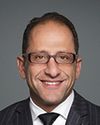Again, with the hybrid cloud edge platform, the data resides on the device itself. It gets calculated on the device. We don't send location information to the cloud. We measure proximity on the device level, and we do proximity mapping using hybrid cloud edge. I would know two devices were close to each other, but I wouldn't know who that device belongs to and where the device has been. That's the most important thing. We provide visibility to the end user to decide which data at which point they want to share with which health care provider.
They have the control to say whether the health care provider can copy or keep the data or if they want to only have access to and view that data. These are the only ways that I as a citizen would use an application like this. I would recommend it to my parents, my sibling, my loved ones. Otherwise, I as a technologist would be the first one to avoid using such technology.
Once I have the contact tracing, there should be an action, an incentivization to share some data. Incentivization should not be with advertising, but should be, for instance, for health care services offering something that I receive in care and support in case I get sick that I would now be willing to share some information with the right person and the right point of contact.



